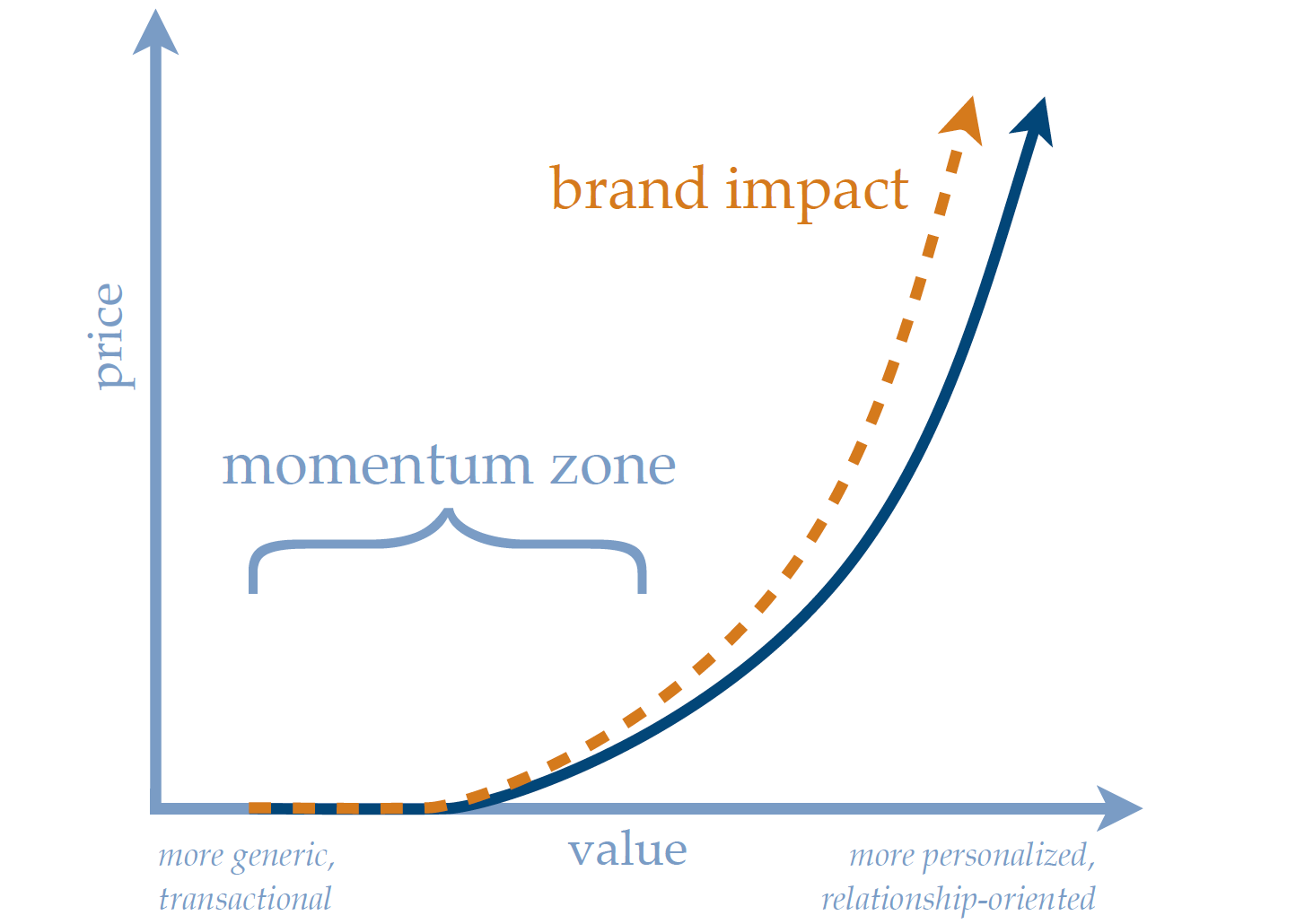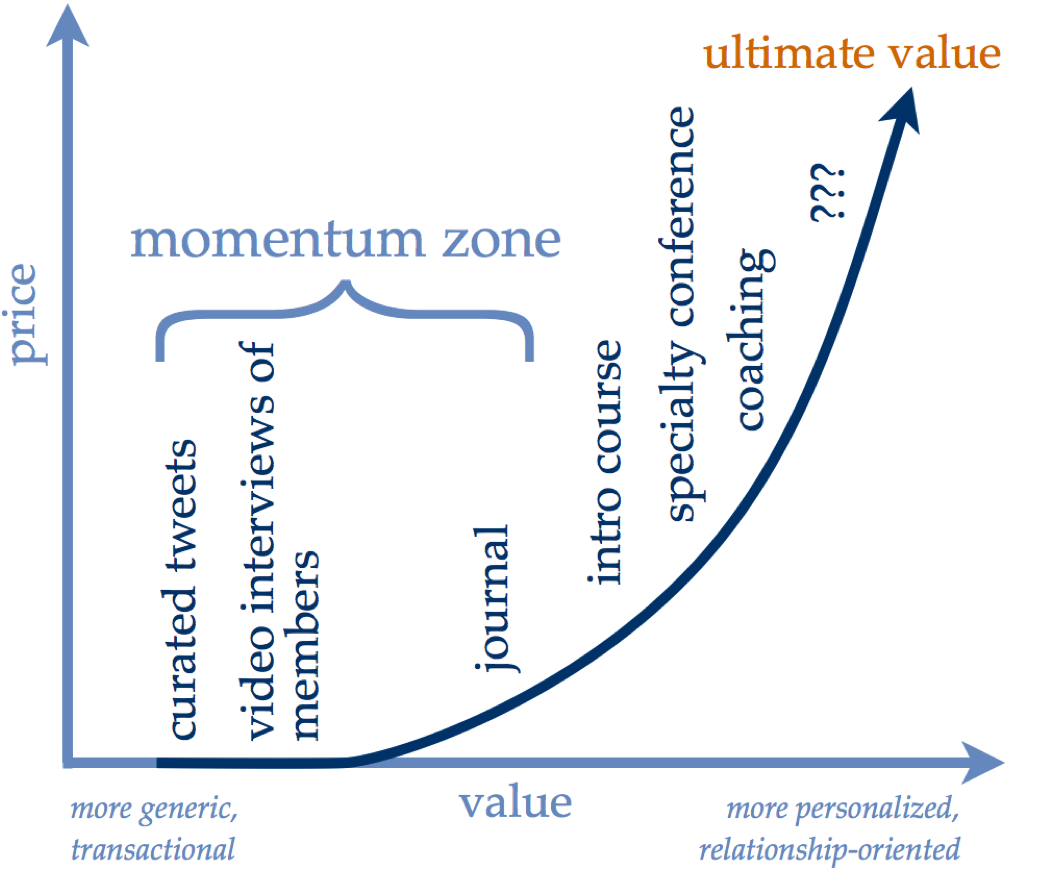Value Ramp™
One of the consistent findings from our periodic research is that relatively few organizations have any sort of formal product strategy or pricing strategy. While not a replacement for a fully thought-out strategy, a simple tool can get you a long ways down the road. That tool is the Value Ramp™.
Read on for an explanation and related videos. You can also download a nicely formatted Value Ramp handout.

Fundamentals of the Value Ramp™
There are a handful of key ideas that underlie the Value Ramp.
First, there is a relationship between price and value when it comes to selling just about any product of service. Provide more value in the eyes of the potential purchaser, and you can and should charge more. (Note: that “in the eyes of the potential purchaser” part is critical.) The upward slope of the curve reflects this relationship.
Second, it’s generally true that to get to a higher place—whether literally or figuratively—you need momentum. In today’s markets, a corollary to this point is that demonstrating value early and often is one of the surest ways to build significant value. More and more, this means providing significant value before you ever charge a dime—which is why the buzz around content marketing has grown so deafening and is unlikely to let up any time soon.
Third, the impact of brand in this price/value relationship can be dramatic. A strong brand can help you build momentum faster, and it can give more power to the price side of the equation, resulting in a steeper value ramp. Basically, the stronger your brand, the more—and more quickly—you are able to charge for the value you offer.
Connecting the Value Ramp to Product Strategy
The Value Ramp tells you a few things about product strategy, and by extension, pricing.
First, you need significant high value at the bottom left of the curve to create momentum. And a good chunk of this value needs to be free—note how the line moves to the right at first, indicating increasing value, without moving up. This initial part of the ramp, in which you provide significant, increasing value at no or low cost, is the momentum zone.
Second, you want your Value Ramp, through the categories of products you place on it, to tell a logical, rational story about increasing value and price. In internal discussions about your products and services, you should be able to clearly articulate the differences in value from one to the next and provide a rationale for increasing price. Whether implicitly or explicitly, it should be easy for your prospective customers to recognize this value continuum.

Third, an extension of the previous point is that you need to provide for a variety of options along your value ramp. The bottom left might include things like blog posts, curated links that you tweet, white papers, or videos. (Note: These things don’t do you a lot of good if they are behind a member login.) Toward the middle, should be higher value, somewhat more cost and labor intensive items like Webinars and on-demand online courses.
Using the Value Ramp to Assess Your Education Portfolio
As you continue to move up the curve, fill it in with items that are increasingly unique to your organization and the value it can provide. These items tend to be more targeted to specific customer segments, but that does not mean they have to be significantly higher in terms of labor and costs. Participation in an exclusive, lightly-facilitated community for people in a specific job role can attract significant fees with relatively low effort.
Think in terms of the ultimate value you could provide to your best customers. What would that look like? What items would you put at the top of the curve to get people to that ultimate value? There’s a question mark here because most organizations have not really thought out this end of the curve. (Most organization have also not thought out the lower left of the curve sufficient. They are stuck in the middle.)
Finally, brand matters. Building a strong brand is critical to attracting people to the curve and to building momentum. Don’t think just in terms of organizational brand, as important as this is, think specifically of your brand as a learning provider, as an organization that can really make significant change happen (which, after all, is what learning is about). The bottom left of your curve should contribute to this brand building initially, but remember, also, that people will likely cycle back to this part of the curve again and again to continue building momentum.
Celisa Steele Discusses Applying the Value Ramp to a Specific Product Line
What to Do Next
The curve does not provide a complete strategy, but it can clarify things really quickly. One of the best ways to use it is to bring together people from across the organization—representatives from all the “silos” that touch your education business—and discuss it. Touch on all of the major points above. Ask yourself:
- How are we building momentum?
- What does ultimate value look like for our key customers?
- How well have we told a value story along the curve?
- How are we building and managing brand to positively impact the curve?
Then ask yourself, “What could we do better in each of these areas?” and you will be most of the way there on having a strategy.
Check out our discussion of the Value Ramp on the Leading Learning Podcast for more about what it is, how to use it, and why.